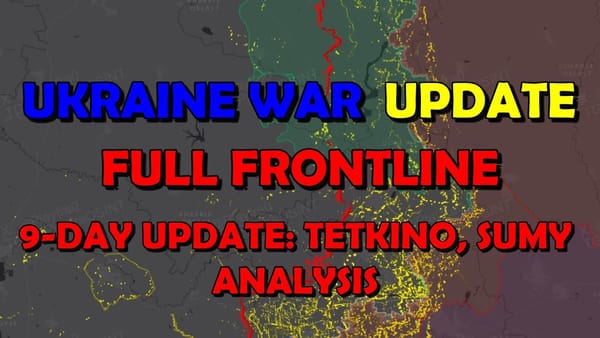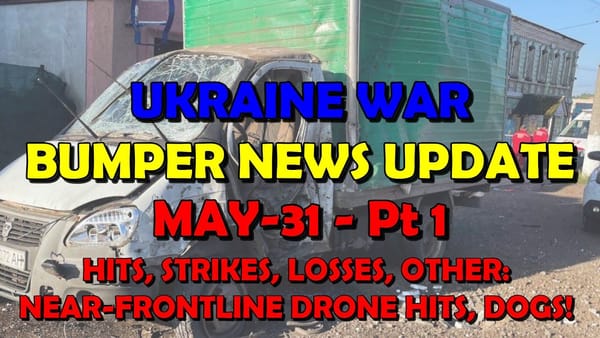Ukraine Conflict: Full Frontline Update, Kharkiv Offensive Update
Table of Contents 📖
Hello Team
🎦 00:00-00:24⏩
Jonathan welcomes viewers to another ATP Geopolitics video, a Ukraine war frontline update for 10th May 2024. He advises viewers unfamiliar with the map key to pause the video and familiarise themselves.
Return to top⤴️
📍 FRONT-LINE UPDATE -🗺️ MAP LEGEND

Kharkiv Offensive Update - Initial Reports and Analysis
🎦 00:24-03:38⏩
Jonathan discusses the Russian offensive in Kharkiv that began that morning. Despite initial claims from Deep State Maps of significant Russian territorial gains, Jonathan expresses scepticism. He highlights a statement from President Zelensky confirming the offensive, but notes that subsequent analysis, including from Deep State Maps, suggests minimal Russian advances. Jonathan believes Russia lacks the necessary troop numbers to take Kharkiv, comparing it to the significantly smaller Bakhmut. He cites analysis by George Barros of the ISW suggesting the offensive aims to fix Ukrainian forces in the region, thereby creating opportunities elsewhere.
Return to top⤴️
Kharkiv Offensive - Comparison to Ukrainian Tactics in Kherson
🎦 03:38-07:19⏩
Jonathan compares the situation in Kharkiv to Ukrainian tactics employed in Kherson. He explains how Ukraine maintains a relatively small bridgehead across the Dnipro River near Krynky, forcing Russia to commit a disproportionate number of troops and resources to counter it. This attrition warfare, Jonathan argues, favours Ukraine, as they inflict heavy losses on Russian personnel and equipment while committing minimal forces themselves. Jonathan draws parallels with the situation in Kharkiv, questioning the logic behind Russia's strategy. He suggests that if Russia aims to fix Ukrainian troops with a diversionary attack, they would need to deploy significant forces to make it effective. However, Jonathan believes that committing such a large force to a distraction would be strategically unsound, as those troops could be better utilised elsewhere for a more decisive offensive.
Return to top⤴️
Kharkiv Offensive - ISW Analysis and Objectives
🎦 07:19-10:13⏩
Jonathan discusses the latest assessment of the situation in Kharkiv by the ISW. The ISW believes the Russian offensive in Kharkiv, while unlikely to capture the city, has several objectives:
- To fix Ukrainian forces across the frontline and create opportunities for Russian advances, particularly in Donetsk.
- To draw Ukrainian troops towards Vovchansk and weaken their defences around Kupyansk, a strategically important city that Russia has been unable to capture.
- To establish a demilitarised buffer zone within Ukraine.
- To sow panic among the Ukrainian population and apply pressure for a resolution to the conflict.
- To set the stage for a larger offensive operation against Kharkiv in the future.
Kharkiv Offensive - Troop Numbers and Russian Tactics
🎦 10:13-13:04⏩
Jonathan continues analysing the ISW's assessment, highlighting the claim that Russia has approximately 50,000 troops in the Belgorod, Kursk, and Bryansk regions. He questions whether this number is sufficient to achieve their objectives, particularly the capture of Kharkiv. The ISW notes that Russian attacks, concentrated northeast of Kharkiv, are currently limited in scope and appear more akin to reconnaissance-in-force missions rather than a determined effort to take the city. Jonathan agrees, pointing to the relatively small number of Russian vehicles involved in the offensive, and the fact that several were destroyed before even crossing the border. He also mentions reports indicating Ukrainian forces intercepted and destroyed Russian aircraft in Russian airspace, suggesting the effectiveness of Ukrainian air defences.
Return to top⤴️
Kharkiv Offensive - Impact of Russian Airspace, Tatar-Grami Analysis
🎦 13:04-16:18⏩
Jonathan argues that Russia’s ability to operate freely within its own airspace poses a significant challenge for Ukraine. He stresses the urgency for the US to provide longer-range air defence systems, allowing Ukraine to intercept Russian aircraft before they can launch attacks. He then shares analysis from military bloggers Tatar-Grami and Rob Lee, both of whom believe Russia seeks to exploit its perceived manpower advantage by forcing Ukraine to divert troops to Kharkiv. This diversion, they argue, could weaken Ukrainian defences in other sectors, such as those near Prokhorovka and Chasiv Yar in Donetsk. Jonathan expresses some scepticism about this strategy, pointing out that defending forces typically require fewer troops than attacking forces, particularly in well-fortified areas.
Return to top⤴️
Kharkiv Offensive - Tatar-Grami on the Nature of the Border and Defence in Depth
🎦 16:18-18:53⏩
Continuing with Tatar-Grami's analysis, Jonathan explains the concept of “defence in depth”. He highlights that the border itself is not a continuous line of fortifications, but rather a “grey zone” heavily monitored by both sides. Ukraine, facing manpower constraints, positions its main defensive lines further back from the border, beyond the range of Russian artillery and drones. This strategy, Tatar-Grami argues, allows Ukraine to avoid costly engagements in areas with limited strategic value while preserving manpower and resources. Drawing from his own experience visiting the Sumy Oblast, Jonathan recounts being in villages within easy range of Russian artillery. He emphasises that fortifications are strategically placed further back to minimize exposure to enemy fire. This reinforces Tatar-Grami's point that ceding control of sparsely defended border villages does not necessarily equate to a significant Russian victory.
Return to top⤴️
Kharkiv Offensive: Zelensky's Response and Ukrainian Troop Movements
🎦 18:53-19:47⏩
Jonathan shares President Zelensky's response to the offensive, stating more Ukrainian troops will be sent to the Kharkiv sector. He notes a degree of uncertainty regarding Ukraine’s available reserves and their ability to reinforce Kharkiv without weakening other areas. He then shares the perspective of a Ukrainian deputy commander, who believes Russia is testing Ukrainian defences and that the offensive was anticipated.
Return to top⤴️
Kharkiv Offensive: Discussion with Zhenya and Explosions in Belgorod
🎦 19:47-21:07⏩
Jonathan mentions a conversation he had with Zhenya, a Ukrainian he met during a previous trip to the country. Zhenya indicated that the situation wasn't causing significant concern among those he had spoken to, suggesting a level of preparedness on the Ukrainian side. The conversation leaves Jonathan feeling more optimistic about Ukraine's ability to repel the offensive. He then shifts focus to explosions reported in Belgorod, speculating that this could be Ukrainian retaliation for the offensive in Kharkiv. He shows footage of an explosion in Belgorod, the nature of which is unclear but speculates that it could be a downed missile or drone.
Return to top⤴️
Ukrainian ATACMS Strike on Oil Depot in Rovenky
🎦 21:07-22:47⏩
Jonathan discusses a Ukrainian ATACMS strike on an oil depot in Rovenky, Luhansk Oblast, which is under Russian occupation. He presents footage of the attack, which caused a massive explosion and fire. Jonathan notes that the US approves of Ukraine using ATACMS missiles against targets within occupied territories. He estimates the missile’s range to be around 150 kilometres.
Return to top⤴️
Frontline Update: Luhansk Oblast
🎦 22:47-23:25⏩
Jonathan proceeds to provide updates from other sectors of the frontline:
- Luhansk Oblast: Russian troops continue assaults near Nevska but haven't been successful in breaking through Ukrainian defences.
- Kupyansk-Svatove-Kreminna line: No significant changes in the last 24 hours.
Frontline Update: Donetsk Oblast
🎦 23:25-25:04⏩
- Donetsk Oblast:
- No significant changes on the Sversk front line.
- No significant changes in the Chasiv Yar sector.
- No significant changes in the northern Avdiivka area near Ocheretyne.
- In the Pervomaiske area, Russian forces have achieved an operational encirclement of Ukrainian positions northeast of Novomykolaivka, as predicted.
- South of Marinka, Russian forces made significant advances to the northeast and south of eastern Krasnohorivka, based on information from the previous day. They are now approximately 700 meters away from their other troops in the area. Jonathan expresses concern for the Ukrainian position in Krasnohorivka.
Analysis: Russian Offensive and Potential Culmination of Russian Advances
🎦 25:04-28:53⏩
Jonathan analyses the day's events, questioning whether Russia's offensive in Kharkiv is a strategic error. He postulates that the relative quietness along other sectors of the frontline could indicate a culmination point in Russia’s offensive capabilities. He notes that the advance on Chasiv Yar has stalled, and according to Ukrainian reports, Russia is sustaining heavy losses, potentially exceeding 1,000 troops daily. He also highlights the increasing effectiveness of Ukrainian artillery, particularly the use of HIMARS, ATACMS, and cluster munitions, in slowing down the Russian advance. This, coupled with potential ammunition shortages on the Russian side, leads Jonathan to believe that the offensive in Kharkiv might be a miscalculation. Jonathan contemplates whether deploying 50,000 troops in other areas, such as near Krasnohorivka, Kupiansk, or south of Velyka Novosilka, would have yielded more substantial territorial gains for Russia. While acknowledging the possibility of unforeseen factors, he remains unconvinced by the strategic rationale behind the Kharkiv offensive.
Return to top⤴️
Wrap Up
🎦 28:53-28:58⏩
Jonathan concludes the video by thanking his viewers and inviting them to share their thoughts.
Return to top⤴️
"I just i just yeah i don't know i don't want to stop the russians from making bad decisions"



